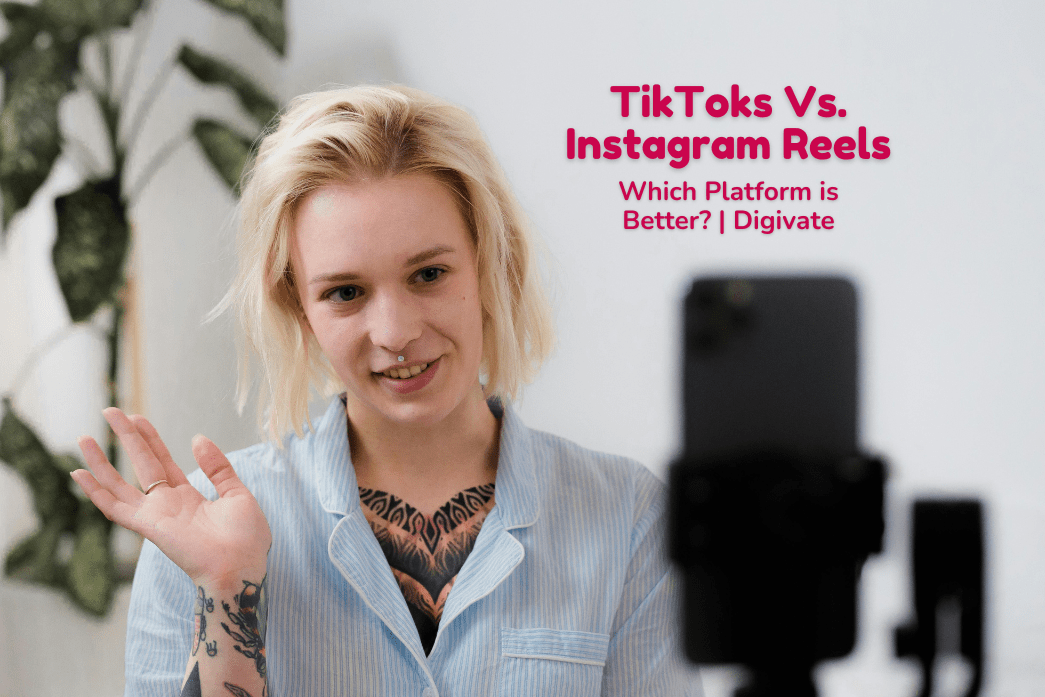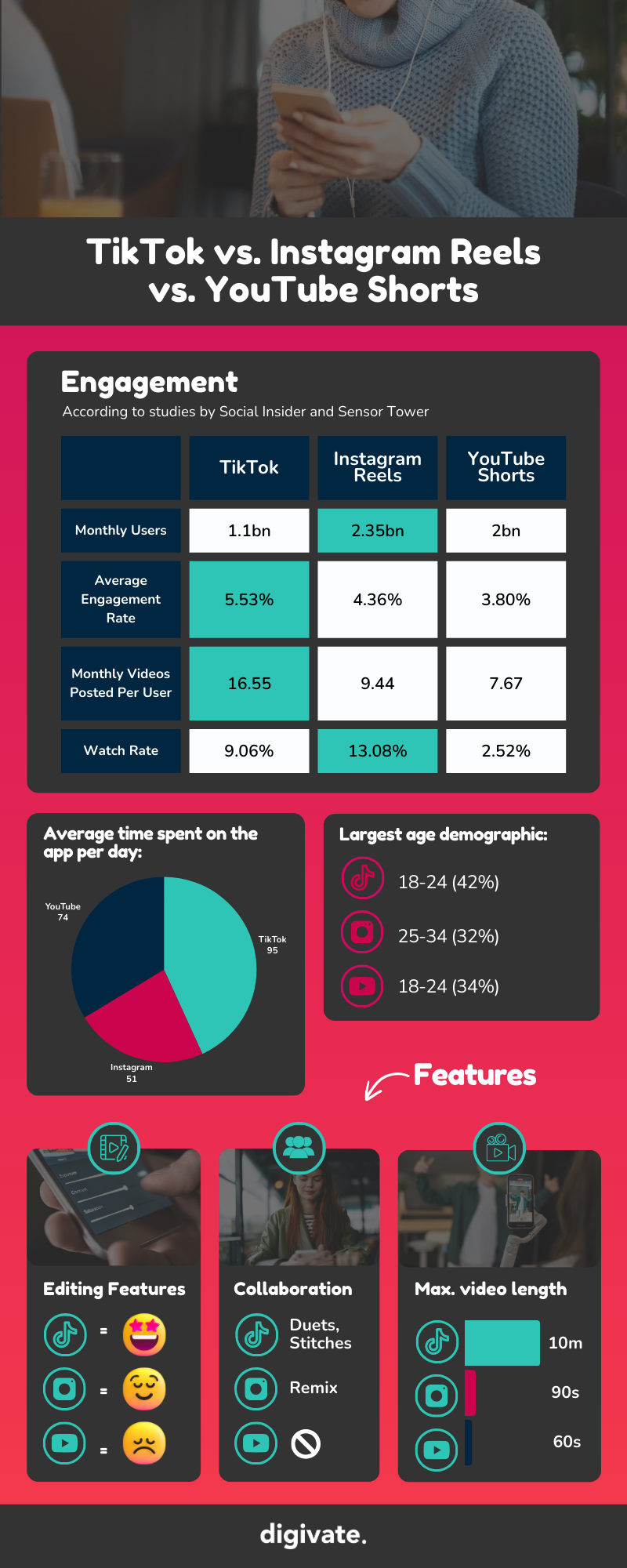
The great short-form showdown of our times is raging on. So how do you decide which social media platform is the best focus for your brand?
In this blog post, we’re going to answer some important questions:
- Which platform has the most users and which gets the most engagement?
- Are TikToks or Instagram Reels better for your target demographic?
- Can you do both? And do you need different content for each platform?

What’s the difference between Instagram Reels and TikToks?
Instagram and TikTok both use an intricate algorithm to distribute short-form video content to a relevant audience. But they’re not two peas in a pod. Here are the key differences.
Video Length:
- TikTok video length: Up to 10 minutes (previously 3 minutes)
- Instagram video length: 90 seconds (previously 60 seconds)
Content Focus:
- TikTok: Video-only, with a focus on challenges, trends, and funny/authentic content.
- Reels: Part of a broader platform with photos and videos, often used for showcasing aesthetics, lifestyle, and brand content.
Editing Features:
- TikTok: More editing tools within the app, including voiceovers, sound effects, green screens and interactive filters.
- Reels: Simpler editing tools, but you can upload pre-edited clips.
Community & Engagement:
- TikTok: Known for its strong community features like Duets and Stitches, which encourage interaction and collaboration.
- Reels: Less emphasis on community features, but you may benefit from an existing follower base on Instagram.
Target Audience:
- TikTok: Younger demographics (Gen Z) with a wider range of interests.
- Reels: More diverse demographics, but they may have a preference for lifestyle and influencer content.
Monetisation:
- TikTok: Limited monetisation options for creators compared to the more established channels … for now.
- Reels: Access to Instagram’s monetisation features like brand collaborations and shopping integrations.
Why you might prefer TikTok:
You can post longer videos, engage in trends and challenges, and easily build community engagement. It’s also the perfect place to reach a younger audience. Gen Z is increasingly using TikTok as a search engine, so if you learn how to do TikTok keyword research, you can really extend your reach.
Why you might prefer Reels:
You can integrate your short-form content with an existing Instagram presence, showcase polished and brand-forward content, and leverage monetisation opportunities.
Which platform is better for paid ads?: Instagram vs. TikTok
TikTok ads are more expensive than Instagram ads. TikTok has an average CPC (cost per click) of £28.94 vs. £22.75 on Instagram and an average CPM (cost per 1000 impressions) of £3.55 vs. £1.35. (Upbeat).
That’s not the full picture, though. TikTok ads have a higher engagement rate – 6.72% – compared to Instagram’s 1.95%.
TikTok also has more ad format options for video content. It offers brand takeovers, branded hashtag challenges and branded effects in addition to in-feed ads.
So, which should you choose for your paid advertising? We recommend posting sponsored content on both platforms if you have the budget! Most businesses invest more of their budget in Instagram as it offers more reach, but if your target audience is Gen Z, TikTok is the best place to do PPC.

Instagram Reels vs. TikToks vs. YouTube Shorts
Instagram and TikTok are also competing with YouTube for the short-form content crown. YouTube Shorts is a different kettle of fish as the platform has historically been used more as a search engine than a social media channel. That said, Shorts is changing the game.
The pros of YouTube Shorts:
- It’s got high search potential
- It has a diverse audience, and all kinds of content can perform well
- You may have an existing YouTube following
The cons of YouTube Shorts:
- You’ve only got up to 60 seconds
- There’s limited community engagement
- Shorts are still seen as an ‘extra’ on YouTube, not the main focus
Which platform gets the most engagement?
TikTok is the fastest-growing social media platform but currently has fewer monthly users (around 1.1bn) than Instagram Reels (2.35bn) and YouTube Shorts (2bn).
The number of users isn’t that important, though, if those users aren’t engaged. So here are some engagement stats!
- The average active user spends 95 minutes per day on TikTok! On Instagram, it’s 51 minutes, and that includes time spent in feeds and stories. Users spend an average of 74 minutes per day on YouTube, but, again, we don’t know how much of that is spent watching Shorts. (Sensor Tower).
- A study by Social Insider found that YouTube Shorts has an average engagement rate of 3.80%, Reels has 4.36%, and TikTok leads with 5.53%.
- It also found that TikTok gets 44% more comments than the other two platforms.
- The average number of videos posted per user also leans in TikTok’s favour. They have an average of 16.55 a month compared to 9.44 on Instagram Reels and 7.67 on YouTube Shorts.
- When it comes to watch rate, though, Instagram wins. Reels have an average watch rate of 13.08% compared to 9.06% on TikTok and a rather sad 2.52% for Shorts.
TikTok vs. Instagram by demographic
TikTok has the most Gen Z users, Instagram has more Millennials, and YouTube has the most even spread of users across age groups.
It’s important to be present where your users are, but you should also consider how your target audience is using each app. If your target audience is Gen Z or Millennial, chances are a huge proportion of them are on both Instagram and TikTok – but they go to TikTok for authentic and funny content and to Instagram for something more aesthetic.
@lachlanfairbairn Tiktok vs instagram #tiktok #instagram #comedy ♬ original sound – lachlanfairbairn
Can you post the same content to Instagram and TikTok?
You can cross-post short-form content, but your performance will vary. Content that performs well on TikTok is usually more spontaneous and authentic. Instagram reels that do well are often more aesthetic and aspirational.
Of course, we don’t all have time in the day to produce videos for both platforms. Editing takes time! We recommend selecting one platform as your primary focus and repurposing content for the other when you’re able to.
Examples of this:
- Film an interview – put the funny bits on TikTok and the more serious stuff on Instagram.
- Post a tightly edited and filtered version of your ‘day in the life’ video to Instagram and a looser cut to TikTok.
- Create a dialogue-free video for Instagram but add a fun voiceover for TikTok.
At first, you might want to experiment with posting the same content to see how each audience responds. We recommend removing the TikTok watermark if you download your videos from the app. You should also make sure you’re using music licensed to each platform. And remember: the max Instagram reel length is only 90 seconds.
How to link Instagram to TikTok
TikTok lets you add links to your Instagram and YouTube pages at the top of your profile. You can do this in your settings. Me > Edit Profile > Add Instagram to your profile > Log in > Authorize.
Note: if you’re wondering how to add Instagram to TikTok so you can repost videos, this won’t work. You’ll have to upload your video manually to each social media platform.
How to adapt your strategy for TikTok and Instagram Reels
It’s important to adapt your short-form social media strategy based on which platform you’re using.
- Adapt the content: For TikTok, experiment with different editing features and voiceovers. On Instagram, use aesthetic filters and showcase your brand.
- Adapt how often you post: Try to post as often as possible on TikTok, daily if you can. For Instagram, 3-5 times a week is fine, and this should include a mix of reels, carousels and single-image posts.
- Adapt when you post: Check when your audience is most active on each platform and post at peak times.
The key to short-form success
We recommend experimenting with short-form content on TikTok, Instagram reels and YouTube shorts before you write off any of these platforms. You’ve got to see what content chimes with your unique audience … and where!
If you’re looking for a short-form content strategy that builds your following fast, get in touch with our social media experts! We use data, technology and user psychology to make a lasting impact on your target audience.



